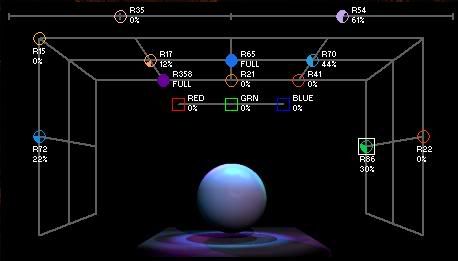In order to begin my research, I needed to create a list of things I would need. Because I already had a good idea on the colors I would use, I decided to focus on the time of day each scene would take place in. Any time I would feel lost or uncertain about where to go next, I would always return to the script. The play, for me, was the one constant among all the changing circumstances and provided the clues I needed to start researching. Historical research did not seem to be of much use to me. But curiosity drove me to research the meaning of the play’s title.
Twelfth Night refers to the end of winter festivities that begins on All Hallows Eve. A common theme during the celebrations is reversal. Shakespeare wrote the play Twelfth Night or What You Will to be performed on the twelfth night using mistaken identity and gender role reversal as part of the story. The play’s title mimicking the date of celebrated misrule only compounded the importance of the main character’s reason for adopting a masculine appearance.
I searched the plays words carefully looking for ideas on what time of day each scene would take place, and then I tried to construct a timeline for the entire play so the transitions would make sense. Unfortunately, this idea was ditched as I began to receive rehearsal reports from the stage manager explicitly stating that the director wished certain scenes to take place at morning or sunset. I decided to follow the director’s wishes rather than dissect the script any further.
Rehearsal reports also clued me in to a new obstacle. The director had rearranged the script’s opening sequence which made my primary resource into a variable instead of a constant. I began re-reading the play for a fifth time trying to imagine the storm that begins the story, but is not scripted out in detail. We only learn about the storm through exposition and now I had to work with the sound designer to actually create it.
It was also at this time I began to question how to deal with the director. I interviewed several members of the department and asked how previous encounters had gone with her. The majority of answers led me to believe that designing this show would be easy, until the last few weeks, which was correct. I’ll address those issues later.
I turned to the High End AF1000 strobes for lightening. I had just seen them in the previous show’s main stage as a lightening effect for The Foreigner and loved the color temperature and wash they created. I considered using PAR lamps to hit the high points of the scenery, but I really wanted to use an instrument I had never used before. I also wanted the chance to try to learn some DMX technology.
I continued searching the script for clues and began scribbling notes in the margins about how each scene should look. My analysis of each scene had already told me the mood, but my final decisions were all based on keywords by characters or the ends of scenes into the next ones.
My first actual encounter with a text clue to the time of day was in act I, scene 3, when Maria says: “By my troth, Sir Toby, you must come in earlier o’ nights.” I figured it was after sunset by then, if Sir Toby is being scolded for returning home so late. I learned from some of Christina Russo’s research on the
I continued in this fashion for the rest of the script, finding keywords and deciding on the time of day for each scene. When I was done, I was better prepared to being color testing. I started with my cast because of the wide range of color tones. Searches on the internet led me to R54, R05, R35, R51, R62, R60 and R33. I began tracking down cast members and quickly lighting them with the gel book and my trusty Maglite.

As for the rest of the colors, I relied heavily on virtual light lab version 1 and version 3. I own a copy of version 1 which is severely limited in options, but version 3 allowed me color test a jpg file of the cyc sent to me by the set designer. I narrowed my selection to a range of purples, blues, and ambers to the cyc; pinks, blues, lavenders, and ambers were still the main choices for back, down and side washes.

No comments:
Post a Comment